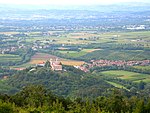Miren Castle
Christian monasteries in the Slovene LittoralHills in the Slovene LittoralRoman Catholic churches in the Slovene LittoralStations of the CrossVincentian monasteries in Slovenia

Miren Castle (Slovene: Mirenski grad, also known as Grad 'castle' and Naša Gospa pod Krasom 'Our Lady beneath the Karst'; Italian: Grado di Merna or Castello di Merna) is an elevation above the settlement of Miren near Nova Gorica, in southwest Slovenia. The origin of the name, which came into usage in the 16th century, remains unexplained. No castle ever stood there. The hill is dominated by a collection of ecclesiastical buildings.
Excerpt from the Wikipedia article Miren Castle (License: CC BY-SA 3.0, Authors, Images).Miren Castle
Miren-Kostanjevica
Geographical coordinates (GPS) Address External links Nearby Places Show on map
Geographical coordinates (GPS)
| Latitude | Longitude |
|---|---|
| N 45.883591666667 ° | E 13.604216666667 ° |
Address
Mirenski grad
215
5291 Miren-Kostanjevica
Slovenia
Open on Google Maps




